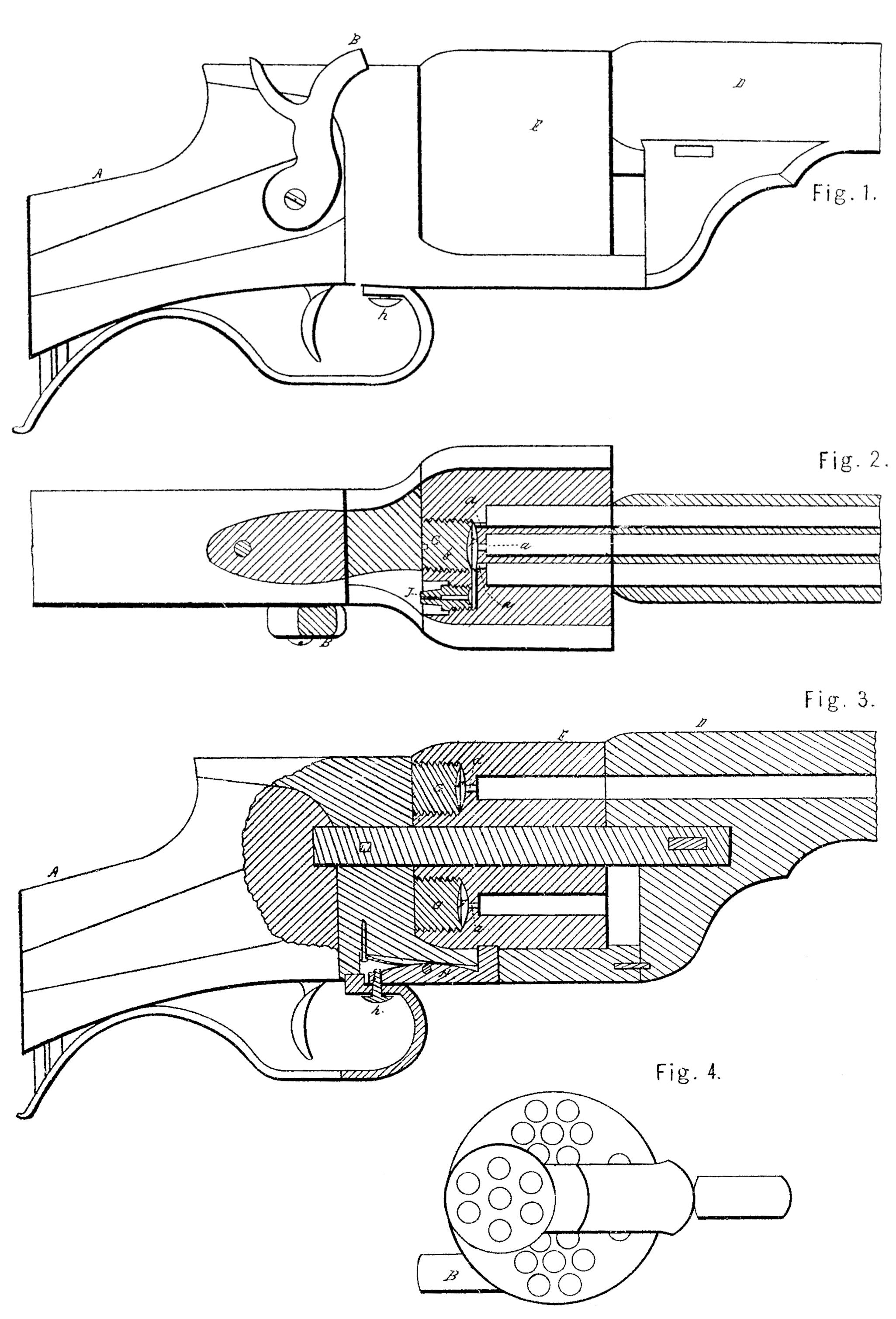US 23087
UNITED STATES PATENT OFFICE.
WILLIAM. C. HAYNES, OF MELROSE, TEXAS.
IMPROVEMENTS IN REVOLVING FIRE-ARMS.
Specification forming part of Letters Patent No. 23,087, dated March 1, 1859.
To all whom it may concern:
Be it known that, I, William C. Haynes, of Melrose, in the county of Nacogdoches, and State of Texas, have invented an Improvement in Revolving Fire-Arms, the construction and operation of which I have described in the following specification and illustrated in the accompanying drawings with sufficient clearness to enable competent and skillful workmen in the arts to which it pertains or is most nearly allied to make and use my invention.
The object, and purpose of my said invention is to provide means for sheeting several charges of buckshot without it reloading, while at the same time these shot, shall be guided with all the precision of a single bullet fired from a barrel of proper bore to fit it. To accomplish this desirable purpose it is necessary that all the shot in each charge shall be fired at once.
My said invention consists in the combination of a barrel which is barrel with several apertures to guide the slot, each separately, with a chambered revolving breech which is pierced with holes or apertures in groups which are bored it such positions is the cylinder or breech that each of these groups shall, when the cylinder is rotated into the proper position, meet or match the group is the barrel, when each separate group in the cylinder, as corresponding with these in the barrel, is so connected to the others in the same group that all its barrels may be discarded by the explosion of a single ca, or other priming, as hereinafter more fully set forth.
In the accompanying drawing, Figure 1 is a side elevation of my improved fire-arm. Fig. 2 s a sectional plan, showing the mode of connecting the chambers so as to discharge several bullets at the same time. Fig. 3 is a sectional elevation. Fig.4 is an end view.
A is the stock, and B is the banner, which is attached to any common gun-lock. D is the barrel.
This gun is intended more especially for shooting buckshot, and is bored to fit the size of shot required, and rifled.
The number of barrels or, more properly, of holes in the barrel D may be varied to correspond with the wants of the user. Seven is the number here represented. These holes in the barrel D connect with the chambers in the cylinder E, which chambers age arranged in groups so as to meet the holes in the barrel. In the cylinder all these chambers in each group are connected by the chamber F immediately back of these charge-chambers, with which charge-chambers they communicate by means of the holes a. This back of the chamber F is closed by the breech-pin G. The hole b connects this chamber F to the cone J, upon which the cap is placed which is intended to fire the charge. By this means all the balls in the group of chambers which is then in communication with the barrel are fired at once, and each ball or shot is separately guided in direct line by the chambers or tubes in the barrel D. By this arrangement a more direct and certain aim is secured, as the shot are not crowded out of line by pressing upon each other, though they are perhaps slightly spread after they leave the barrel by the compression of air between them; but this last effect does not turn the whole charge aside from its course, but, on the contrary, is beneficial, as it makes the shot cover a little larger mark.
The cylinder is held it position during the discharge by the spring-catch H. This catch is operated to release said cylinder by pressing the finger upon the key h, and the cylinder is rotated by hand.
I do not claim a barrel which has several holes for bullets or shot; nor do I claim many-chambered rotating cylinder as such, it as delivering bullets to a single barrel. Neither do I claim any device for discharging several barrel at the same time.
The particular improvement which constitutes my said invention, and which I claim as having been originally and first invented by me, is—
Combining with a stationary barrel having several tubes or chambers for shot a rotating cylinder having groups of chambers, each group of chambers being so arranged as to correspond with the chamber or tubes in the barrel, and also so arranged in connection with a single cone or its equivalent to each group that the explosion of the cap or its equivalent shall fire the whole group to which the cone upon which it was exploded belongs, the whole being constructed and operating substantially as set forth.
WILLIAM C. HAYNES.
Witnesses:
B. Hardeman, Jr.,
I. C. Short, Jr.

